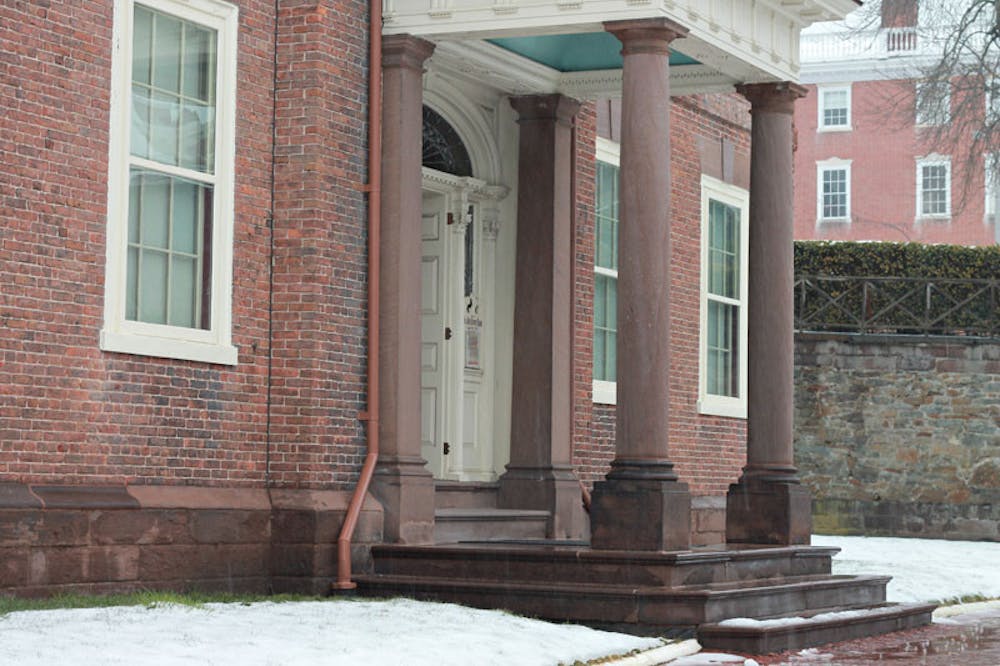From 1905 to 2013, an elm tree spread its roots in the original yard of the John Brown House in Providence.
Originally planted by owner Marsden Perry to create a “park-like setting” in his yard, the tree has “been here longer than any of us have, sheltering our family and our grandparents’ family,” said Kathy Clarendon, Rhode Island Historical Society Director of Development and Public Relations.
But that long existence was cut short March 11 when the 108-year-old tree, threatened by deadly contagious disease, was cut down.
Timber!
Because of infection by a lethal canker, a dead section of the bark usually caused by environmental or pathogenic damage, the tree was chopped down in its entirety in only a short hour and 37 minutes.
“It’s sad that something so majestic had to go by the wayside,” said Dale Broholm, senior critic in the Rhode Island School of Design department of furniture design, who witnessed the tree coming down. He added that the tree is both historically and culturally significant because it watched the City of Providence grow.
The tree’s fall interested more than woodturners, furniture designers and the media. A passerby from a nearby law office came and stayed for almost the entire hour and half, taking pictures of the spectacle, Clarendon said.
A tall tale and order
The RIHS, which owns the John Brown House, offered pieces of the tree to Broholm, the Ocean Woodturners and the Cape Cod Woodturners.
“We wanted to make sure the wood went to a good home,” Clarendon said, adding that the tree is a testament to the “history of the grown environment.”
Like its long years and large importance, the tree’s destruction also has a high cost. Clarendon said chopping the tree and treating the surrounding trees that have developed cankers will total about $10,000.
The RIHS has asked the woodturning societies to donate back some of the objects that they create from the wood of the tree to help with fundraising.
The giving tree
President of Ocean Woodturners Wayne Collins will ask each of his society members to give one of the pieces they create to John Brown House for every piece that they keep, he said. “It’s a win-win all around,” he said.
“Everyone is going to have their own version of what the tree should be remembered by,” Collins said. He personally plans to make a bowl — to recycle the tree into such a utilitarian piece is important, he said.
“It makes me happy that others will continue to benefit from it,” he said.
Clarke Buchanan of Cape Cod Woodturners will distribute the wood he receives among the 45 active members of his club and ask them to give back some of the pieces they create as well.
“We love to turn wood,” he said. “We would rather turn it to last many more years than to see it chopped up and used for firewood.”
The RIHS originally offered Broholm wood to use in his class at RISD, entitled “Witness Tree Project.”
In the class, students examine history and material culture by making commemorative objects out of the wood of historic trees from places ranging from the George Washington Birthplace National Monument to the Sagamore Hill National Historic Site. But because the National Park Service exclusively grants the wood to the class, Broholm had to decline RIHS’ offer.
Instead, he is helping coordinate the distribution and drying of the wood and plans to save a piece to turn it into a table for the RIHS.
Though the tree has been chopped down, the woodturners’ objects aim to preserve the history it has seen.
“It’s sort of like that perfect diamond or that ’57 Chevy that your grandpa drove that you wished you saved,” Collins said. “We should make something out of it that will live longer than the tree.”

ADVERTISEMENT




